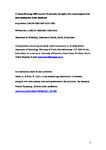Cross-sectional age differences in 24 character strengths: Five meta-analyses from early adolescence to late adulthood
| dc.contributor.author | Heintz, Sonja | |
| dc.contributor.author | Ruch, W | |
| dc.date.accessioned | 2021-03-05T21:52:22Z | |
| dc.date.issued | 2022-05-04 | |
| dc.identifier.issn | 1743-9760 | |
| dc.identifier.issn | 1743-9779 | |
| dc.identifier.uri | http://hdl.handle.net/10026.1/16927 | |
| dc.description.abstract |
The present study comprises five meta-analyses (47 samples with a total N of 1,098,748) that investigate cross-sectional age differences in the 24 character strengths entailed in the VIA model. It is expected that most strengths show age differences, especially higher levels throughout adulthood. Ten age groups from early adolescence (10–12 years) to late adulthood (65+ years) were compared for each strength using random-effects models. Overall, significant age differences were found for 23 of the 24 character strengths (all except perspective) across the lifespan, with 91% of the effects indicating higher levels of the character strengths with age. Effect sizes were mostly very small, in line with age differences found for other traits. Most age differences were found for creativity, curiosity, love of learning, zest, and self-regulation as well as in middle adulthood. These results provide an impetus for research and applications on the development of character strengths. | |
| dc.format.extent | 1-19 | |
| dc.language | en | |
| dc.language.iso | en | |
| dc.publisher | Informa UK Limited | |
| dc.subject | Character strengths | |
| dc.subject | meta-analysis | |
| dc.subject | age differences | |
| dc.subject | VIA model | |
| dc.subject | lifespan development | |
| dc.subject | interventions | |
| dc.title | Cross-sectional age differences in 24 character strengths: Five meta-analyses from early adolescence to late adulthood | |
| dc.type | journal-article | |
| dc.type | Journal Article | |
| plymouth.author-url | https://www.webofscience.com/api/gateway?GWVersion=2&SrcApp=PARTNER_APP&SrcAuth=LinksAMR&KeyUT=WOS:000616570700001&DestLinkType=FullRecord&DestApp=ALL_WOS&UsrCustomerID=11bb513d99f797142bcfeffcc58ea008 | |
| plymouth.issue | 3 | |
| plymouth.volume | 17 | |
| plymouth.publication-status | Published | |
| plymouth.journal | The Journal of Positive Psychology | |
| dc.identifier.doi | 10.1080/17439760.2021.1871938 | |
| plymouth.organisational-group | /Plymouth | |
| plymouth.organisational-group | /Plymouth/Faculty of Health | |
| plymouth.organisational-group | /Plymouth/Faculty of Health/School of Psychology | |
| plymouth.organisational-group | /Plymouth/REF 2021 Researchers by UoA | |
| plymouth.organisational-group | /Plymouth/REF 2021 Researchers by UoA/UoA04 Psychology, Psychiatry and Neuroscience | |
| plymouth.organisational-group | /Plymouth/REF 2021 Researchers by UoA/UoA04 Psychology, Psychiatry and Neuroscience/UoA04 Psychology, Psychiatry and Neuroscience MANUAL | |
| plymouth.organisational-group | /Plymouth/Research Groups | |
| plymouth.organisational-group | /Plymouth/Research Groups/Plymouth Institute of Health and Care Research (PIHR) | |
| plymouth.organisational-group | /Plymouth/Users by role | |
| plymouth.organisational-group | /Plymouth/Users by role/Academics | |
| dcterms.dateAccepted | 2020-12-06 | |
| dc.rights.embargodate | 2022-2-9 | |
| dc.identifier.eissn | 1743-9779 | |
| dc.rights.embargoperiod | Not known | |
| rioxxterms.versionofrecord | 10.1080/17439760.2021.1871938 | |
| rioxxterms.licenseref.uri | http://www.rioxx.net/licenses/all-rights-reserved | |
| rioxxterms.type | Journal Article/Review |


